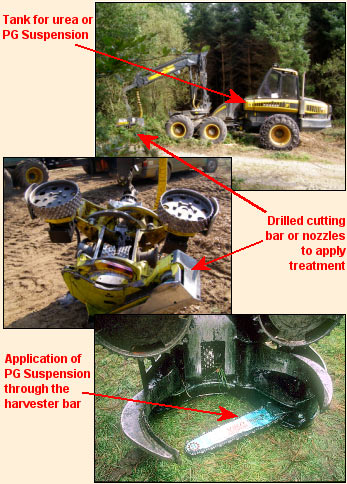A biological control agent for Heterobasidion species (sometimes colloquially referred to as “Fomes” or “butt rot”).
The Forestry Commission, in common with the public forestry bodies in Scotland and Wales, has a commitment to reducing chemical usage in forests in line with the aims of the United Kingdom Woodland Assurance Standard (UKWAS). Although chemical stump treatment using urea is practised on many conifer species planted in the UK, a non-chemical alternative produced by Forest Research is available for use on Pinus species, and has been used in Thetford forest in East Anglia for the past 30 years.
This biological control agent is called PG Suspension and the active ingredient is a wood-rotting saprophytic fungus, Phlebiopsis gigantea. This fungus does not attack living trees, but when applied to stumps prevents surrounding trees becoming infected with Heterobasidion species by competing for resources on the stump surface.
It is currently only licensed for use on Pinus species in the UK.

A biological control agent for Heterobasidion species.
Instructions on the safe handling of the product are clearly displayed on the product label and leaflet. Those that appear as statutory conditions are legal requirements and must be complied with.
Because PG Suspension is made up of live fungal spores, special care is needed in its storage and handling to maintain its efficacy. Sachets must be kept refrigerated at between 3 oC and 5 oC before use, and exposure to high temperatures will kill the spores. The chilled product has a shelf life of about six months and the expiry date is clearly displayed on the label.

Once the spores have been mixed with water they germinate, and their shelf life is reduced to 24 hours. Therefore new working solutions must be made up every day. Any solution remaining in the tank at the end of the day must be emptied onto a stump, so do not make up more solution than you need. Make up the solutions with clean water in clean containers free from residues. Bacteria can build up on the sides if tanks are not cleaned regularly, and this might affect the viability of the solutions, and in extreme conditions create a health hazard.


Apply PG Suspension as soon after felling as is possible, and within 30 minutes. Stumps need to be completely covered to ensure adequate levels of control, and to aid treatment a dye can be added to the solution to provide a marker on the stump. Note that this dye must be compatible with the living product, and not present a health hazard to the operator or the environment.

A biological control agent for Heterobasidion species.
If you intend to use equipment which has previously been used to apply urea, make sure all the tanks and hoses are thoroughly rinsed with clean water before using PG Suspension because the urea might impair the viability of this biological product.
PG Suspension is a biological control agent for Heterobasidion species, which cause conifer root and butt rot.
PG Suspension is manufactured at Forest Research’s Alice Holt Lodge research station in Surrey. An average of three batches are produced each year to supply Forestry England East District.
The product is a suspension concentrate comprising live spores (oidia) and mycelium of P. gigantea. The formulation contains a mix of spores, water, sugars and colour additives.
The PG Suspension mixture is pumped into sterile plastic tubing and sealed at intervals to produce small sachets which contain 7-10ml of product. If kept refrigerated the product will retain its viability for six months because the low water activity (aw) of the formulation ensures that the growth of most bacteria and yeasts is prevented.
 P. gigantea mycelium is scraped off malt agar plates
P. gigantea mycelium is scraped off malt agar plates Spores are mixed with sugar water and honey
Spores are mixed with sugar water and honey The solution is pumped through plastic tubing
The solution is pumped through plastic tubing Completed sachets
Completed sachetsEach sachet must contain several million spores per millilitre of concentrated product in order to be successful. The concentration of viable spores is monitored before the product is dispatched to the field, and another mid-term test on viability is carried out in the laboratory to ensure the product has not deteriorated over time.
A biological control agent for Heterobasidion species.
PG Suspension is approved for use by HSE under MAPP number 17009. It is a legal requirement that the regulatory authority HSE is provided with full reports of any adverse human effects from exposure to the product.
Use is subject to normal health and safety provisions of the Health and Safety at Work Act (HASAWA), and the Control of Substances Hazardous to Health (COSHH) Regulations.
Before use risk assessments must be carried out and appropriate control measures put into place.

A biological control agent for Heterobasidion species.
1 box of PG Suspension contains 50 sachets.
For further information about PG Suspension, its application and use, please email katherine.tubby@forestresearch.gov.uk